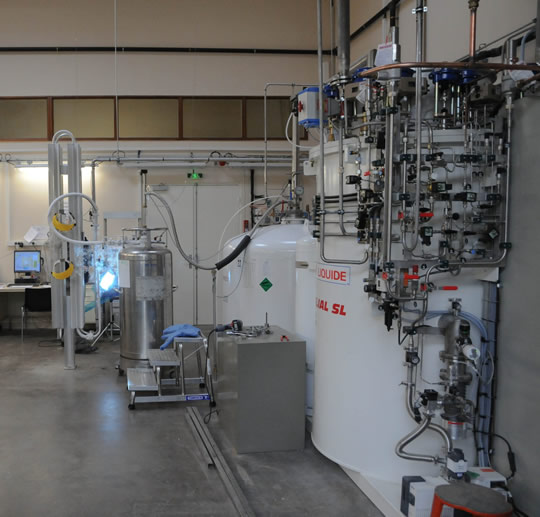

We can easily heat matter with a flame. However, cooling matter is trickier. Understanding very low temperatures and trying to reach them began in the 19th century and is still at the heart of many research subjects. In order to reach very low temperatures – a branch of physics called “cryogenics” – we use machines that pump the heat out of an object in order to cool it. Refrigerators and freezers work on the same principle. In that case, electricity supplies an energy that is mechanically converted to pump the thermal energy from the fridge, hence cooling what is inside it. Thermodynamics enables to optimize this type of machines. Thanks to the Joule-Thomson effect in particular, gases can be cooled to temperatures so low they become liquids.
 It is precisely by liquefying gases that lower and lower temperatures were reached: -183°C for oxygen, -196°C for nitrogen, -253°C for hydrogen. Once obtained, these liquids cannot be heated, they only evaporate, the same way liquid water cannot be heated over 100°C, but simply evaporates while boiling. It is then possible to plunge samples in these liquids to measure what happens to matter at a very low temperature.
It is precisely by liquefying gases that lower and lower temperatures were reached: -183°C for oxygen, -196°C for nitrogen, -253°C for hydrogen. Once obtained, these liquids cannot be heated, they only evaporate, the same way liquid water cannot be heated over 100°C, but simply evaporates while boiling. It is then possible to plunge samples in these liquids to measure what happens to matter at a very low temperature.
At the beginning of the 20th century, helium was the only gas that had not been liquefied. Helium is a really light inert gas that was first observed in the light spectrum produced by the sun. On earth, it is extracted from natural gas fields in the United States, in Russia or in Algeria. In 1908, Kammerlingh Onnes was the first person to liquefy helium.
 He discovered that helium becomes liquid at only 4.2 degrees of absolute zero (-269°C) and when he pumped the steam above the liquid, the temperature of liquid helium dropped to 1.6 degrees of absolute zero! This is how Onnes was able to measure the properties of matter at temperatures twenty times lower than what had been reached before (on the Kelvin scale), by plunging samples in liquid helium. This technique enabled him to measure what happens with electric resistance in metals and to discover superconductivity in 1911 !
He discovered that helium becomes liquid at only 4.2 degrees of absolute zero (-269°C) and when he pumped the steam above the liquid, the temperature of liquid helium dropped to 1.6 degrees of absolute zero! This is how Onnes was able to measure the properties of matter at temperatures twenty times lower than what had been reached before (on the Kelvin scale), by plunging samples in liquid helium. This technique enabled him to measure what happens with electric resistance in metals and to discover superconductivity in 1911 !
Today, low temperature physicists know how to reach even lower temperatures in laboratory, within millionths of a degree from absolute zero, thanks to always more ingenious cryogenic devices: dilution cryostats, adiabatic demagnetization, Pomeranchuk cell, etc.… Be careful though because at such temperatures, the mere definition of temperature must be handled with care!
